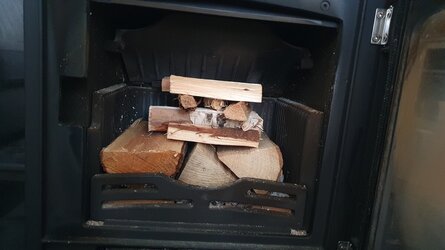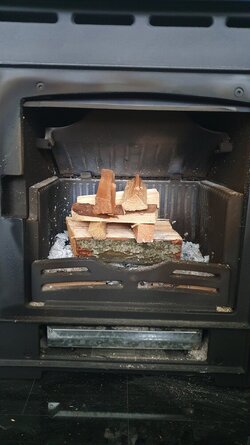Uncontrollable flame
- Thread starter scaryflame
- Start date
-
Active since 1995, Hearth.com is THE place on the internet for free information and advice about wood stoves, pellet stoves and other energy saving equipment.
We strive to provide opinions, articles, discussions and history related to Hearth Products and in a more general sense, energy issues.
We promote the EFFICIENT, RESPONSIBLE, CLEAN and SAFE use of all fuels, whether renewable or fossil.
You are using an out of date browser. It may not display this or other websites correctly.
You should upgrade or use an alternative browser.
You should upgrade or use an alternative browser.
joop
Minister of Fire
joop
Minister of Fire
joop
Minister of Fire
joop
Minister of Fire
fill inside box to top with your splits put kindling on top,it's going to burn up fast anyway then do your procedure for shutting air.see how it goes
Hahaha. But scary flame!jeez at least fill the first row lol
Some do actually, pic attached!can your log fit n/s
I can't - I'll search again ...Do you see 2 other areas air can enter? That might be secondary.
Yeah my stove aint getting up to temp at all recently.you do know that with that amount of wood your burn is going to last about 20 min max
How about this.. this will be the most I've ever put in it starting off.fill inside box to top with your splits put kindling on top,it's going to burn up fast anyway then do your procedure for shutting air.see how it goes

joop
Minister of Fire
go for it, once the kindling burns put 2 more decent splits on top and then work it like usual.if you haven't lit it yet put three big splits on top of other big splits and just a few small pieces of kindling and let her go
stoveliker
Minister of Fire
Possibly, but not for sure.
The heat output of a stove is governed by the burn rate of the fuel in there. The burn rate is limited by the amount of oxygen that's available. So even with a stove stuffed full with three times as much wood, if the air can be restricted enough, it won't produce three times as much heat per hour - instead, it will produce heat three times as long. (Many caveats here, but that's the general idea.)
Having the least amount of primary flame ("connected to/coming from" the wood), and the only flame coming from near the air holes at the top means you are limiting the oxygen like I mention above - there's not enough to have flames on the wood, but it's glowing and off gassing, and those gases ignite at the top. (This all assumes your chimney has the proper draft.)
Edit: For this to work, it is important to first get the wood to burn, i.e. run a bit higher, get primary flame, so the wood is hot/glowing/offgassing. Then dial down the air, and "switch" to secondary flame only (or mostly). The trick is to dial down at the right moment. Too late, and a lot of wood will be gassing at the same time and the room may get too hot. Too early, and you dont' have enough wood engaged in the combustion process to sustain secondary flame etc.
The heat output of a stove is governed by the burn rate of the fuel in there. The burn rate is limited by the amount of oxygen that's available. So even with a stove stuffed full with three times as much wood, if the air can be restricted enough, it won't produce three times as much heat per hour - instead, it will produce heat three times as long. (Many caveats here, but that's the general idea.)
Having the least amount of primary flame ("connected to/coming from" the wood), and the only flame coming from near the air holes at the top means you are limiting the oxygen like I mention above - there's not enough to have flames on the wood, but it's glowing and off gassing, and those gases ignite at the top. (This all assumes your chimney has the proper draft.)
Edit: For this to work, it is important to first get the wood to burn, i.e. run a bit higher, get primary flame, so the wood is hot/glowing/offgassing. Then dial down the air, and "switch" to secondary flame only (or mostly). The trick is to dial down at the right moment. Too late, and a lot of wood will be gassing at the same time and the room may get too hot. Too early, and you dont' have enough wood engaged in the combustion process to sustain secondary flame etc.
Last edited:
joop
Minister of Fire
I don'thave either of those, but can pick up a tile saw if needed.I have used tile saws and angle grinders to cut firebrick.
Haha - yeah true.what he said lol if it gets hot open window and sit in the kitchen with a cold brew.
So I chucked it on as it was, the birch at top burned fine but the Ash (3 splits at bottom) just did not burn well at all. Opened the door up and could hear hissing at one stage so this 'kiln dried wood' I was sold wasn't kiln dried. Though I did use a moisture meter on it, was around 16-18%.
Either way, haven't had the Ash burn well yet. Main thing is, the chimney didn't go up on flames, the opposite ha.
I WANT THE SCARY FLAME BACK!
Beast of a reply - need to digest it some more but thanks as always!Possibly, but not for sure.
The heat output of a stove is governed by the burn rate of the fuel in there. The burn rate is limited by the amount of oxygen that's available. So even with a stove stuffed full with three times as much wood, if the air can be restricted enough, it won't produce three times as much heat per hour - instead, it will produce heat three times as long. (Many caveats here, but that's the general idea.)
Having the least amount of primary flame ("connected to/coming from" the wood), and the only flame coming from near the air holes at the top means you are limiting the oxygen like I mention above - there's not enough to have flames on the wood, but it's glowing and off gassing, and those gases ignite at the top. (This all assumes your chimney has the proper draft.)
Edit: For this to work, it is important to first get the wood to burn, i.e. run a bit higher, get primary flame, so the wood is hot/glowing/offgassing. Then dial down the air, and "switch" to secondary flame only (or mostly). The trick is to dial down at the right moment. Too late, and a lot of wood will be gassing at the same time and the room may get too hot. Too early, and you dont' have enough wood engaged in the combustion process to sustain secondary flame etc.
stoveliker
Minister of Fire
To properly measure with a moisture meter, you need to measure on the *inside* of the split - that's where the water is coming from that is hissing.I don'thave either of those, but can pick up a tile saw if needed.
Haha - yeah true.
So I chucked it on as it was, the birch at top burned fine but the Ash (3 splits at bottom) just did not burn well at all. Opened the door up and could hear hissing at one stage so this 'kiln dried wood' I was sold wasn't kiln dried. Though I did use a moisture meter on it, was around 16-18%.
Either way, haven't had the Ash burn well yet. Main thing is, the chimney didn't go up on flames, the opposite ha.
I WANT THE SCARY FLAME BACK!
So you have to get your axe or wedge, and split two of the splits in half, and then push the pins in (along the grain) on the freshly exposed "inside" surface. The higher moisture content will be in the middle, as the wood dries from the outside in.
And preferably you have to do this with a piece of wood that is at room temperature (a good way to get it up to room temp is to simply have it lay in your living room for 24 hrs, and not near the stove).
Sweet - now I have to go buy an axe :DTo properly measure with a moisture meter, you need to measure on the *inside* of the split - that's where the water is coming from that is hissing.
So you have to get your axe or wedge, and split two of the splits in half, and then push the pins in (along the grain) on the freshly exposed "inside" surface. The higher moisture content will be in the middle, as the wood dries from the outside in.
And preferably you have to do this with a piece of wood that is at room temperature (a good way to get it up to room temp is to simply have it lay in your living room for 24 hrs, and not near the stove).
Fiskars 25 or 27, what you think?
TomMcDonald
Feeling the Heat
27 definitely. Unless you're 5' or under.Sweet - now I have to go buy an axe :D
Fiskars 25 or 27, what you think?
joop
Minister of Fire
joop
Minister of Fire
It's terminology. They are calling the air wash secondary when it's really more like primary air. And the primary air on this stove is more like boost air for starting.Do you see 2 other areas air can enter? That might be secondary.
stoveliker
Minister of Fire
As in boost, primary and secondary?
1, 2, and 3... which we call secondary...
The point is that here we count by flame types, and there by number of air inlets...
1, 2, and 3... which we call secondary...
The point is that here we count by flame types, and there by number of air inlets...
Yes, though they call them differently and not by flame types.As in boost, primary and secondary?
1, 2, and 3... which we call secondary...
The point is that here we count by flame types, and there by number of air inlets...
Similar threads
- Replies
- 8
- Views
- 1K
- Replies
- 8
- Views
- 2K
- Replies
- 10
- Views
- 653



 lol
lol